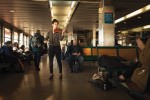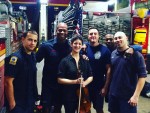Column Name
Title
Subhead
Between November 19 and December 22, Michelle Ross performed J.S. Bach’s complete violin sonatas and partitas in daily free pop-up concerts throughout New York City.
Body
In 2014, I was in the midst of recording my first CD, the complete Bach solo violin cycle. During my preparation, I found myself vacillating between bliss and frustration in my solitude, and by the end, I felt an urge to share Bach with a wide audience in an intimate and accessible way. The year before, the anonymous graffiti artist Banksy created a new piece of public art throughout New York City every day for a month. The art was free, the audience limitless. In creating this intersection between public and private spheres, Banksy was a model to me of an artist who could reach a wide and diverse audience without having to dilute his product. Suddenly Bach and Banksy began to dance together in my mind. Could I find a way to bring Bach to a new and unknown audience in a profound, intimate way? I would need to find public spaces that had inherent potential for a deep listening experience.
I saw this as a liberating project, one which could perhaps help me take Bach down from the pedestal I’ve had him on while acknowledging and embracing my lifelong journey as a violinist with these works.
I think of Bach as an architect, and I view this set of six sonatas and partitas as essentially one work of art. Bach leads us inward through four minor keys, setting the Ciaconna in the deepest part of the work (in the Partita No. 2 in D Minor), after which we have the heartbeat of the C-Major Adagio of the Sonata No. 3. Through the purity of C major, we find our way back to earth, and Bach ends the cycle with the sweet, exalted joy of the E-Major Partita No. 3. Following the recording, I found myself wanting to create a physical experience of spelling out the cycle in order to feel this cumulative geography.
And so starting in November, I performed every day in 33 different public spaces, ranging from a Brooklyn firehouse to a veterans hospital in the Bronx. I used each day as a personal meditation on one of the 27 movements and performed at least the complete corresponding sonata or partita. On the final day, I performed all six sonatas and partitas in a “pied piper” marathon all over the city. The whole experience was a double journey—the spiritual and musical journey of the works intersected with the physical one.
I started at the Hungarian Pastry Shop near Columbia University, where I’d gone as an undergrad. I was absolutely terrified to interrupt the energy of chatting and studying, so I tried to make myself invisible, tuning as quietly as possible. But from the instant my bow touched the A string, the room fell silent, which stunned and moved me. The coffee shop had transformed into a roomful of strangers with open hearts, and it was an exquisite way to open the first page of Bach’s score. Three weeks later, I played at Rockefeller University on a balcony within a six-story atrium, and my sound drew people out of their labs from every floor of this building. I played for 30 minutes, and nobody moved. Over the course of these four and a half weeks, this project taught me how to urge people to listen, rather than to ask. It confirmed my instinct that you don’t have to say a word or “educate” a new audience; if you can gently frame the experience and give people a hint toward how to listen, the music will open them up.
On the final marathon day, I performed the Ciaconna in the sublime acoustics of the Cathedral of St. John the Divine. This was the closest experience of the 33 days to being on a concert stage with the audience far away from me, and I missed the tension of hearing them breathe.
Being an artist in New York City, isolated at work in a studio, can feel sometimes like being lost at sea, so it’s beautiful to remember that there is always someone who can benefit from hearing your music, and it may surprise you how much you get in return. I witnessed my own disposition changing throughout the month, as I became open to the city and strangers, with every subway ride an adventure.
Having performed in an M.T.A. bus, the Buzzfeed office, museums, libraries, Coney Island, soup kitchens, police precincts, the High Line, a retirement home, Trader Joe’s, and the Brooklyn Boulders climbing gym, I feel that with a violin I can walk into any room and, without saying anything, have the tools to be able to lead someone to be honest with me. It is a spectacular thought that almost 300 years after Bach left this music to the world, it can reach another person’s soul on the Staten Island Ferry.
The dialogue between performer and audience can teach us about our craft and bring us closer to the music. Bach left us a blueprint: he said, “build the cathedral.” We might not know what the stones or windows will look like in the sunlight, but every day we get to rebuild the cathedral, we get a new chance. We are trying to comprehend the essence of the music and translate his universe from the inanimate realm of a score to the physical realm of a live experience. For 33 days, I had the experience of building cathedrals all around New York City.







